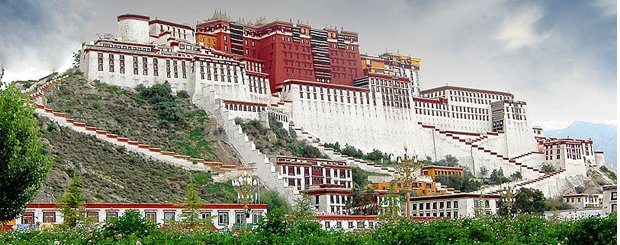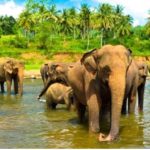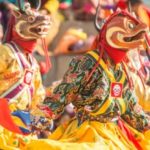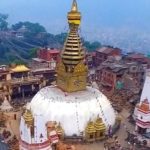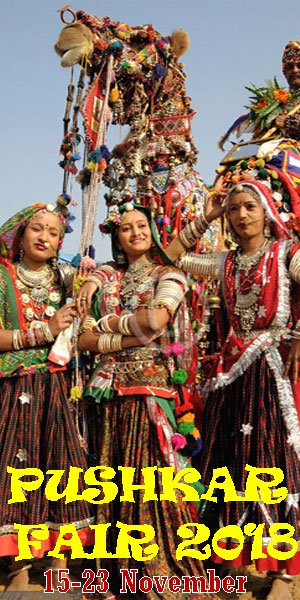Discover Tibet
DAY 01: ARRIVE KATHMANDU
Arrive Kathmandu by international flight. Meeting and assistance on arrival and transfer to hotel. Afternoon city tour of Kathmandu, known as Kantipur, the capital of the Kingdom of Nepal. Here you will visit the temple of the Living Goddess who acknowledges the greetings of the devotees from the balcony of her temple residence.
Kashtamandap – the source of the name Kathmandu and supposed to be made from the timber of a single tree and the Durbar Square are with its array of temples overlooked by the Hanuman Dhoka Palace, the ancient place of the Nepalese Royalty. Dinner and overnight at the hotel.
DAY 02: IN KATHMANDU
Breakfast at hotel. Morning excursion to Pashupatinath, Bodhnath and Bhadgaon.
PASHUPATINATH: Situated 5 km east of Kathmandu City, Pashupatinath temple is one of the holiest temples dedicated to Lord Shiva. Situated amidst a lush green natural setting on the bank of the sacred Bagmati river, the temple built in pagoda style has gilded roof and richly carved silver doors. Visitors will be permitted to view the temple from the east bank of Bagmati river, entrance in the temple being strictly forbidden to all non-Hindus. Pashupatinath is the centre of annual pilgrimage on the day of Shivaratri which falls in the month of February/March. Behind the temple are the cremation grounds.
BODHNATH: This Stupa, 8 km east of Kathmandu City, is one of the biggest in the world of its kind. It stands with four pairs of eyes in the four-cardinal direction keeping watch for righteous behavior and human prosperity. This Buddhis Stupa was built by King Man Deva at the advice of the Goddess Mani Jogini. It is built on an octagonal base inset with prayer wheels. The shrine is ringed by houses of Lamas or Buddhist priest.
BHADGAON: Also known as Bhaktpur meaning the city of devotees, this place is the home of medieval art and architecture. Lying 14 km/9 miles of Kathmandu City, this place was founded in the 9th century and is shaped like a conch shell. The city is at the height of 4,600 ft. above sea level. In Bhadgaon you will visit the Durbar Square with its array of temples overlooked by the Palace of 55 Windows built by King Bhupatindra Malla. Here you will also visit the Taleju Temple which is the best example of Pagoda style structure in Nepal and stands on five terraces on each of which stands a pair of figures, two strong men, two elephants, two lions, two griffins and two goddesses. Dinner and overnight at the hotel.
DAY 03: KATHMANDU – LHASA BY FLIGHT
Breakfast at hotel. In time transfer to airport to connect flight for Lhasa. Meeting and assistance on arrival at Lhasa airport (where the altitude is 3595m/11792ft above the sea level, it needs some time to acclimatize the altitude). Tibetan Guide transferred to the hotel in the city. Take rest for acclimatization. You will experience some mild symptoms of altitude sickness. Drink plenty of water.
In the evening, you are invited for Tibetan welcome dinner with Tibetan cultural performance. Dinner and overnight at the hotel.
DAY 04: IN LHASA
Breakfast at hotel. Morning visit Potala Palace, Norbulingka Palace and Sera Monastery.
Potala Palace: This architectural wonder is Lhasa’ cardinal landmark. It can be seen from all directions for miles around. Potala was set up in the seventh century AD during the reign of King Songtsen Gampo. It’s located on the Red Hill, covers an area of 41 hectares. At an elevation of more than 3,700 m, the Potala occupies an area of more than 360,000 m. Its 13-story main portion rises 117 m. The whole complex, consisting of halls, stupa-tomb halls (where the relics of the supreme lamas are preserved), shrines, prayer rooms, monks’ dormitories and courtyards, is recognized as the world’s highest and largest castle palace.
Sera Monastery: The Sera Monasteries are known as the 3 great monasteries of Tibet. All belonging to the lineage of Gelugpa started by Je Tsong Khapa in early 15th century and all are within Lhasa, capital of Tibet. Contrary to common-understanding, these great monasteries are not places of worship and rituals but are in reality monastic universities providing religious education to the monks from age 8 to up to 70 in some cases. We can do the Sera Kora walk of about 1 hr and then catch the famous debate session (if the debate session is in process) of the monks before returning-back to Lhasa.
Norbulinka Monastery: The park was begun by the 7th Dalai Lama beginning in 1755. The Norbulingka Park and Summer Palace were completed in 1783 under Jampel Gyatso, the Eight Dalai Lama, on the outskirts of Lhasa. and became the summer residence during the reign of the 8th Dalai Lama. The stables of the Dalai Lamas in Norbulingka, photographed in 1986.The earliest building is the Kelsang Potang Palace built by the 7th Dalai Lama which is “a beautiful example of Yellow Hat architecture. Its fully restored throne room is also of interest”. The ‘New Palace’ was begun in 1954 by the present Dalai Lama and completed in 1956. It contains chapels, gardens, fountains and pools. The gardens are a favourite picnic spot and provides a beautiful venue for theatre, dancing and festivals, particularly the Sho Dun or ‘Yoghurt Festival’, at the beginning of August, with families camping in the grounds for days surrounded by colourful makeshift windbreaks of rugs and scarves and enjoying the height of summer weather.The palace is located three kilometers west of the Potala Palace which was the winter palace. Additional buildings were added to the park during the first half of the 20th century. There is also a zoo at Norbulingka, originally to keep the animals which were given to the Dalai Lamas. Dinner and overnight in Lhasa.
Breakfast at hotel. Morning visit Drepung Monastery. After lunch, visit Jokhang Temple and then walk on the Barkhor street surrounding Jokhang, a big free market with its prolific stalls for selling local specialties.
Drepung Monastery: Drepung Monastery was established near Lhasa, Tibet in 1416 by Chojey Tashi Palden. It had four departments, of which Loseling, or “The Hermitage of the Radiant Mind,” was the largest, housing more than three quarters of Drepung’s ten to fifteen thousand monks. Drepung Loseling was especially close to the Dalai Lama incarnations; the Second Dalai Lama made his residence here in 1494, and subsequent incarnations maintained this link.
Jokhang Temple: The Jokhang temple, a massive building consisting of three floors and an open roof all filled with chapels and chambers, has undergone extensive reconstructions and additions since the 7th century, particularly during the 17th century reign of the fifth Dalai Lama. While parts of the existing temple structure date from earlier times, most of the murals are from the 18th and 19th centuries and few statues (with the notable exception of the Joyo Sakyamuni) are older than the 1980’s. The temple was sacked several times during Mongol incursions but its worst treatment has been at the hands of the Chinese since their occupation of Tibet in 1959. The Jokhang is the most celebrated temple in Tibet. Because the temple is not controlled by a particular sect of Tibetan Buddhism it attracts adherents of all the sects as well as followers of Bon-Po, Tibet’s indigenous religion. Three pilgrimage circuits exist in Lhasa, each directing pilgrims to the Jowo Sakyamuni statue: the Lingkhor, which encircles the city’s sacred district; the Barkhor, which encloses the Jokhang temple; and the Nangkhor, a ritual corridor inside the Jokhang. Every day throughout the year hundreds of pilgrims circumambulate each of these three circuits. Some pilgrims will cover the entire distance by prostrating every few feet, and others will walk slowly, chanting sacred mantras and spinning hand-held prayer wheels. For more than a thousand years, millions of pilgrims have trod these sacred paths with devotion in their hearts; this cumulative focusing of intention and love has charged the Jokhang with an enormously powerful field of sanctity.
Barkhor Street: The center of the old Lhasa, Barkhor is a circular street, which is the oldest street in Lhasa and remains very traditional. It is a place where Tibetan culture, economy, religion and arts assemble and a place to which a visit must be paid. It was said that in the seventh century when Songtsen Gampo, the first Tibetan King (617 or 650) who unified Tibet, married Chinese Princess Wencheng and Nepal princess Tritsun. Later Princess Tritsun built Jokhang Temple to accommodate the Jowo Sakyamuni aged 12 brought to Tibet by Princess Wencheng. Barkhor is the road which pilgrims tramped out around Jokhang Temple through centuries. Buddhist pilgrims walk or progress by body-lengths along the street clockwise every day into deep night. They comprise most of Lhasa’s floating population. Dinner and overnight in Lhasa.
DAY 06: LHASA – GYANTSE BY ROAD via YAMDROK TSO
After breakfast you will leave for Gyantse (255 km / approx 5.5 hrs drive). En route you will enjoy the beautiful Scorpion shaped Yamdrok Lake. Before that you will visit the Drolma Lhakang Temple. You will have you best picture shot of Yamdrok lake at the highest alivation en route to Gyantse, Kampa La above below 4800 meters.
Yamdrok Lake: After an hour or so driving from Lhasa, you will reach the foothill of Kampa la. From the view point of Kampa La, you will have your best view of Yamdrok Lake. Though you will not see the scorpion shaped lake (view map) but you will see the sky blue water also snow capped in winter. You will drive along the Yamdrok lake for about an hour to Gyantse. On arrival to Gyantse you certain will be tired. Driver and guide will drove you to the hotel where its booked. Rest of the day at leisure. Dinner and overnight in Gyantse.
DAY 07: GYANTSE – SHIGATSE BY ROAD
Breakfast at hotel. Morning drive to Shigatse (95 km) en route visiting Kumbum and Pelku Chode. These are the very important sightseeing spots of Gyantse.
Kumbum: The first Kumbum was founded in the year 1427 by a Gyantse prince. It has nine lhakangs or levels, is 35 meters (115 ft) high surmounted by a golden dome, and contains 77 chapels which line its walls. It is in the shape of a 108-sided mandala. Kumbum means 10,000 images. The stupa raises over four symmetrical floors and is surmounted by a gold dome, which rises like a crown over four sets of eyes that gaze serenely out in the cardinal directions of the compass.
Many statues were destroyed during the cultural revolutions and have been replaced by clay images. But it lacks the artistic merits of original.
Pelku Chode: The Phalkor Monastery was founded in 1418 and was designed by Newari architects from Nepal. The former has a special influence over Buddhism owing its unity of Gelugpa, Sakyapa and Bhuton sects. Pelku Chode is the Monastery inside the same compound of Kumbum.
On arrival to Shigatse you will be driven to Hotel followed by visit of Shalu Monastry. Dinner and overnight in Shigatse.
Breakfast at hotel. Morning visit Tashilunpo Monastery.
Tashilunpo Monastery: Tashilunpo Monastery was founded in 1447 and is the largest Yellow Hat sect monastery in Tibet. Shigaste is Tibet’s 2nd most important city and Tashilunpo was the seat of the Panchen Lamas. Tashilunpo contains chortens, temples and the Panchen Lama?s palace. At its peak, Tashilunpo had more than 4,000 monks in its 4 monasteries. Upon the death of a Panchen Lama, it was the 4 abbots of these monasteries that would lead the search for his infant reincarnation.The monastery is a striking red, white and black Tibetan structure with a golden roof. Within the monastery there is a 5 story temple, which contains a 26 meters (86ft) sitting statue of the Maitreya Buddha. The statue was cast from 6,700 ounces of gold and over 115,000 kg of copper, making it the biggest copper Buddhist statue in the world. The massive Thangka wall at Tashilunpo can be clearly seen from most points in Shigaste. The wall is used for displaying enormous Thangkas – religious painted banners – for only a few festival days each year. Dinner and overnight in Shigatse.
DAY 09: SHIGATSE – LHASA BY ROAD
Breakfast at hotel. Morning free for strolling around and visit the local market. Later you will be driven back to Lhasa taking the north route. Upon arrival at Lhasa, check-in at hotel. Rest of the day free for independent activities. Dinner and overnight in Lhasa.
DAY 10: LHASA – KATHMANDU BY FLIGHT
Breakfast at hotel. In time transfer to airport to connect flight for Kathmandu. Upon arrival at Kathmandu connect another flight for onward destination.
Social Share
Destination Tours
Discover Sri Lanka
Discover Bhutan
Discover Nepal
Travel Themes
India Tour Packages
Useful Links
Contact Us
Suite No 207 RG Complex, Plot-08, Central Market Sector-05, Dwarka
New Delhi 110075
INDIA
Phone : +(91-11) 42730400
WhatsApp: +91-8800222776
CIN : U63040DL2003PTC120106 GSTIN: 07AABCE2211M1ZX

 Fixed Departure
Fixed Departure